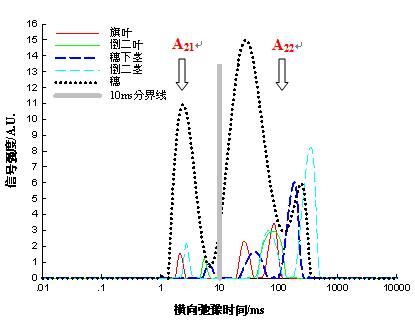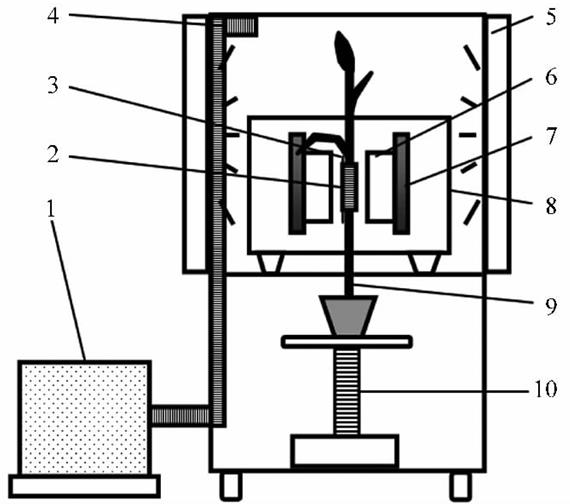How to monitor water state and migration in living plants by low field NMR technique
Because the state and fluidity of cell-associated water are closely related to cell conditions. NMR images represent a physiological map of tissues and can be used to study the hydrodynamics of cell metabolism.
T2 relaxation time and its corresponding amplitude are given by NMR T2 relaxation spectrum. The T2 relaxation time reflects the dynamic characteristics of water molecules and is related to the size and structure of the microregion where water is located, the content of water-soluble sugar and the permeability of biofilm, and the amplitude is corresponding to the water content.
Fig 1. Study on the relationship between NMR characteristics and relative water content of wheat
1. Temperature and humidity control box 2. RF probe 3. The outer tube 4. Wind pipe 5. Light box 6. Permanent magnets 7. Yokes of iron 8. Magnet incubator 9. Wheat plants 10. Lifting platform
Fig 2. MRI analysis system for living plants
The living plant NMR analysis system is an online living plant testing system. An artificial climate chamber was constructed outside the magnet box to ensure the climate control of plants during in vivo detection. That is, aluminum alloy is selected as the load-bearing frame. The side of the box is made of plexiglass, and the light box is placed on both sides of the box. The temperature and humidity control system of the artificial climate box is an independent box body, which includes air conditioning, humidifier and fan controlled by the temperature and humidity controller and is connected with the artificial climate box through the air duct.
The amplitude of T2 relaxation spectrum of NMR is proportional to 1H content, which is used to analyze water, oil, and starch content. Theoretically, 1H NMR signals can be generated by both water molecules and biological macromolecules, but their relaxation characteristics are quite different. The 1H T2 relaxation time of biological macromolecules bound by chemical groups is much smaller than that of water molecules. For example, the 1H T2 relaxation time of lipid molecules is about 200-400ms, while that of pure water is about 2s. In addition, the T2 relaxation of water is affected by interfacial effects, and the T2 relaxation time of central vacuole water is longer than that of cytoplasmic water and cell wall water. The structure and composition of plant tissues are complex and the T2 relaxation spectrum is usually multicomponent. However, the difference of T2 relaxation spectrum of various components in different organs is obvious. For example, the T2 relaxation spectrum analysis of oil content of oil seeds requires that the water content of samples is less than 15%. NMR T2 relaxation spectroscopy can effectively detect water content, water state and water migration process in roots, stems, leaves, seeds and fruits of plants.
Reference:
1. Nuclear magnetic resonance analysis of wheat leaf senescence, Transactions of the Chinese Society for Agricultural Machinery.
2. Water Distribution and Variation of wheat based on nuclear magnetic resonance technology, Chinese Journal of Agricultural Engineering.
 NIUMAG
NIUMAG

